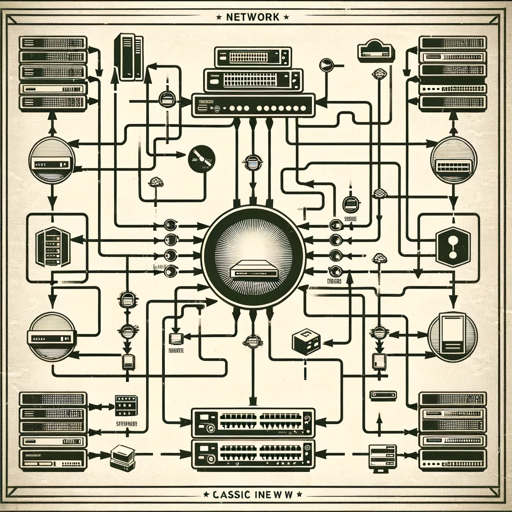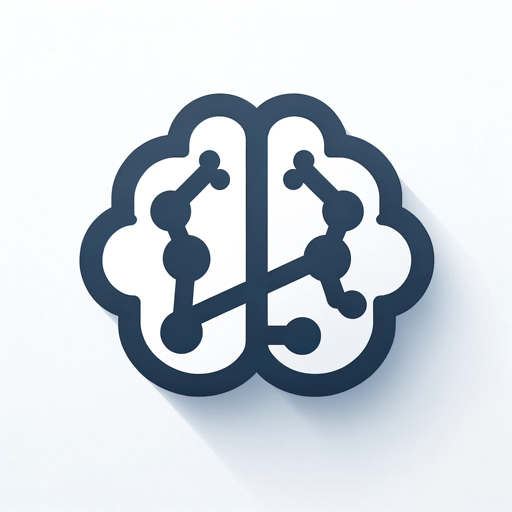Network Topology Creator-AI-powered Network Topology Creator
AI-Powered Network Design and Visualization
Draw a network topology with these components:
How would this network look in a diagram?
Visualize a network setup with the following elements:
I need a topology for this network configuration:
Related Tools
Load More
Graph Maker
This GPT can provide guidance on the most appropriate type of graph for different data sets, such as bar charts, line graphs, pie charts, scatter plots, and more.

Diagram Creator [UPDATED]
Expert in transforming ideas into professional diagrams

IT Architecture Diagram Generator
To create IT Architecture diagram for the requirement given

Network Wiz
Expert in creating complex network diagrams with customizable styles and shapes.

Graph Maker
Specialist in creating diagrams and graphs based on user requests

Neural Network Creator
Assists with creating, refining, and understanding neural networks.
20.0 / 5 (200 votes)
Introduction to Network Topology Creator
Network Topology Creator is a specialized tool designed to assist professionals in creating detailed and accurate network topology diagrams. The primary purpose of this tool is to streamline the process of visualizing complex network infrastructures, whether for planning, documentation, or troubleshooting. It is designed to generate network diagrams that adhere to industry standards, such as those used in Cisco Packet Tracer, and it labels each device clearly to ensure easy identification and understanding. For example, imagine a scenario where an IT team is tasked with designing a new office network. They need to ensure that the layout includes all necessary components such as routers, switches, firewalls, and end-user devices. Network Topology Creator can be used to create a detailed visual representation of this network, helping the team to visualize how the devices will connect and interact, identify potential bottlenecks or vulnerabilities, and communicate the design effectively to stakeholders.

Key Functions of Network Topology Creator
Creating Network Diagrams
Example
The tool allows users to create detailed network topology diagrams by dragging and dropping various network devices onto a canvas. Each device can be connected via virtual cables to simulate real-world network connections.
Scenario
A network engineer is tasked with documenting the current network setup for a large corporation. Using Network Topology Creator, they can quickly build a comprehensive diagram that includes all routers, switches, servers, and end-user devices. This visual map can then be used for future troubleshooting, upgrades, or audits.
Labeling and Annotating Devices
Example
Network Topology Creator automatically labels each device on the diagram, but also allows for custom annotations, making it easier to include additional information like IP addresses, VLAN IDs, or specific configuration details.
Scenario
In a scenario where multiple departments share the same network infrastructure, it is crucial to annotate the diagram with departmental boundaries, IP ranges, and any specific routing rules. This ensures that the network's layout is clear to all stakeholders, reducing the risk of misconfiguration.
Customizing Visual Styles
Example
The tool provides options to customize the visual appearance of the network diagram, including color-coding devices by type, adjusting line styles for connections, and applying specific layout algorithms to improve readability.
Scenario
During a network upgrade presentation to non-technical executives, the IT team uses Network Topology Creator to generate a visually appealing and easy-to-understand diagram. By customizing the colors and layout, they can highlight key changes and make the information accessible to a broader audience.
Target User Groups for Network Topology Creator
Network Engineers and Architects
These professionals are the primary users of Network Topology Creator, as they are responsible for designing, implementing, and maintaining network infrastructures. The tool helps them to create accurate and detailed network diagrams that can be used for planning, documentation, and troubleshooting purposes. Its ability to generate industry-standard visuals is particularly valuable for these users.
IT Managers and Consultants
IT managers and consultants benefit from using Network Topology Creator by gaining a clearer understanding of the network's architecture. This enables them to make informed decisions regarding upgrades, security measures, and capacity planning. Consultants, in particular, can use the tool to create clear and professional diagrams that help communicate complex network designs to clients.

How to Use Network Topology Creator
Visit aichatonline.org for a free trial
Access the Network Topology Creator directly without requiring a login or ChatGPT Plus subscription.
Prepare Your Network Requirements
Define the scope of your network design, such as the number of devices, types of connections, and specific configurations.
Choose a Topology Layout
Select from a variety of pre-configured network topologies or customize your own, depending on your project’s needs.
Add and Configure Network Devices
Drag and drop network devices such as routers, switches, and firewalls into the topology. Configure each device according to your requirements.
Generate and Review the Network Diagram
Once configured, generate the visual network diagram, review it for accuracy, and make adjustments as necessary before exporting.
Try other advanced and practical GPTs
ProofReader
AI-Powered Proofreading for Flawless Text

Grammar Checker
AI-powered Grammar Perfection

News Transformer
AI-Powered News Article Transformer

PrestaShop Developer Assistant
Empower Your PrestaShop Development with AI

Pinecone Assistant
AI-powered vector database assistant.

Senior Angular Code Reviewer
AI-powered Angular code optimization and review.

Algebra Mentor
AI-powered solutions for algebraic problems

Get Vedic Answers - HH Mahavishnu Goswami Maharaj
AI-powered Vedic guidance for your spiritual journey.

The SEO Auditor - Full Technical & On-page Audits
AI-powered technical and on-page SEO audits.

Laravel vuejs Inertia
AI-powered Laravel Vue Inertia integration.

Maths assistant
AI-powered math solutions, simplified.

Expert Botanist Plant Doctor Botany Wizard
AI-powered botanical expertise at your fingertips.

- Network Design
- Visual Documentation
- Topology Creation
- Device Configuration
- Traffic Simulation
Frequently Asked Questions About Network Topology Creator
What types of network devices can be included in a topology?
The Network Topology Creator supports a wide range of devices including routers, switches, firewalls, servers, and end-user devices. You can also customize device configurations to match real-world setups.
Is there a way to save and export the created topologies?
Yes, once you’ve completed your network topology, you can save your work and export the diagram in various formats such as PNG, SVG, or PDF for documentation or presentations.
Can I simulate network traffic within the tool?
While the tool primarily focuses on creating and visualizing network diagrams, it also provides basic simulation capabilities, allowing you to test traffic flow and identify potential bottlenecks.
Does the tool support collaboration for team projects?
Yes, the Network Topology Creator includes collaboration features that allow multiple users to work on the same project simultaneously, making it ideal for team-based network design tasks.
How accurate are the network configurations generated by the tool?
The tool uses industry-standard templates and configurations, ensuring high accuracy in the generated topologies. It’s suitable for both educational and professional use cases.